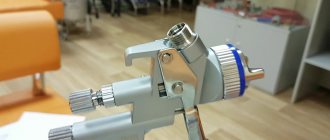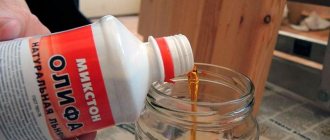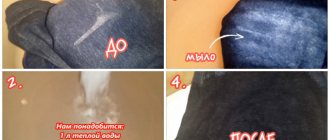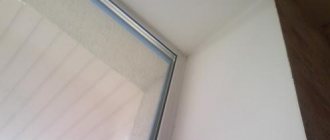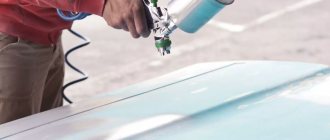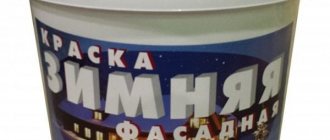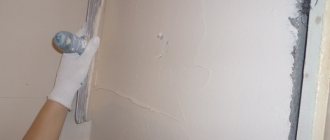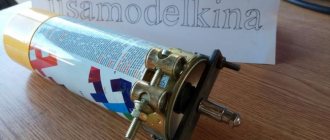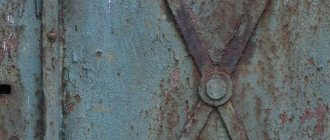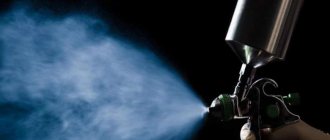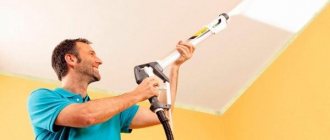Carrying out repair work involves painting various surfaces. You can use a roller or brush for this. However, a spray gun is considered a more convenient and modern device. This device has different types, which differ in design. Therefore, recommendations on how to use a spray gun are also different.
The use of a spray gun has many features
What types of spray guns are there: features of the tool and its types
Using a spray gun helps you quickly paint large surfaces - for example, walls, floors or ceilings. In addition, this device allows you to apply paint in a thinner and more dimensional layer. It makes it possible to use different types of substances - water-based, oil, acrylic.
Based on design features, the following types of devices are distinguished:
- Pneumatic - these manual devices include a tank, a receiver and a compressor. This element forces air into the atomizer. Then, under high pressure, it breaks the paint into small fragments and pushes it out of the nozzle. Due to this, it is possible to obtain a dye torch.
- Electric - such products include a built-in pump. During operation, it does not form small particles. Therefore, the painted surface is not so ideal. However, such spray guns also have many advantages - they are distinguished by their compact size, light weight and affordable price.
Note! The devices also differ in the location of the tanks. It can be top, bottom or side.
Spray guns are produced by different manufacturers. The highest quality devices are presented in the range of companies Bosch, Kalibr, Prorab, SATA. You can also use Energomash or FIT devices.
Creation of various decorative coatings
Interior items are painted antique in loft style:
- After covering the base with primer and sanding, black dye is applied.
- The dried surface is treated with a second layer - light CM.
- The dried decorative coating is processed with coarse sandpaper.
- Varnishing is in progress.
Veranda, bathroom, covered with sheets, are additionally treated with antibacterial agents. After this, waterproof plywood paint is applied.
Beautiful tabletops are created: a pattern is applied to the painted base and varnished; Using an old bristle brush, an imitation of marble, plastic, or metal is created on the surface of the shield.
What to do with the spray gun before work
Before you paint any surfaces with a spray gun, the tool needs to be set up. This procedure must be performed after filling the tank with paint or varnish. It is important to close the lid tightly.
To configure the device, it is recommended to do the following:
- Adjust air and paint flows. To do this, the tool must be hung vertically and pointed at a sheet of newspaper.
- Press the trigger and wait for smudges to appear on the sheet.
- Adjust the sprayer and move the device in different directions to obtain an even layer.
Before operation, the device must be configured correctly
Applying varnish
Sometimes varnish is used instead of paint. The plywood is first cleaned and sanded using sandpaper or a sanding machine, then it must be cleaned of any accumulated dust and degreased. Otherwise, all dirt will be visible under the varnish.
After applying the first layer of varnish, let it dry. Sand the first layer and then cover the surface with another layer. As a result of this approach, varnished plywood becomes dull.
If you want to get a glossy surface, you need to apply another layer of varnish on top. This time it is advisable to apply it using a sprayer to evenly distribute the varnish composition.
Operating rules
How to paint correctly with a spray gun? To get a good result, it is important to follow the key recommendations and take into account the type of surface.
Basic techniques for painting simple surfaces
To properly paint surfaces, you need to know how a spray gun works. You should start painting from the corner of the plane. The device must be placed 10-15 cm from the edge of the element and moved from left to right. The next strip must be applied lower than the previous one. At the same time, it should overlap it by 50%. These steps must be repeated until the surface is completely painted.
Painting and plastering of walls
To paint the walls, they need to be divided into sections. You need to paint one at a time, going 10-12 cm on top of each other. If necessary, you can make certain adjustments by changing the spray distance, pressure or nozzle size.
Important! To achieve good results, the composition must be applied in 2 layers. The second layer can be done only after the previous one has completely dried.
To apply textured plaster, a cartouche gun is used. In this case, its nozzles should have a diameter of 6-8 mm. The material should be sprayed at a distance of 10-15 cm. In the case of using gypsum material, the interval is reduced to 5-10 cm.
The device is perfect for painting walls
Painting the ceiling
When painting the ceiling, the following rules must be observed:
- to apply a uniform layer, ensure a jet length of no more than 70 cm;
- the spray of paint should be applied perpendicular to the surface;
- the second layer is applied only after the first has dried;
- The surface must be painted in a circular motion.
Wood and plywood work
Wood is considered a material that has a fragile surface with a high degree of permeability. It quickly breaks down when exposed to moisture. This is why it is so important to provide high-quality waterproofing.
When painting furniture or other wooden products, they must be treated with a primer, varnish, or hydrophobic impregnation. To protect wooden objects that are located outdoors, they need to be properly prepared, primed and impregnated. It is best to use oil paints.
Important! It is advisable to use a wood spray gun for large volumes of work. So, painting a wall with such a device is much faster than with a brush.
The device helps to paint wood surfaces
Painting of metal products
The spray gun is often used to paint metal objects - for example, car bodies. It is important to properly prepare the surfaces. To do this, it is recommended to do the following:
- clean the surface of dirt and old paint;
- treat the surface with a solvent;
- rinse with clean water;
- putty the damaged areas;
- apply primer.
Painting metal surfaces is often accompanied by the appearance of bubbles and streaks. That’s why many people are interested in how to properly paint metal with a spray gun. To do this you need to follow these rules:
- turn off the device as rarely as possible;
- move the device slowly, without making sudden jerks;
- apply layers in parallel;
- paint elements from different sides;
- keep the interval.
The spray gun is good for painting cars
Application of hammer paint
This substance allows you to get the effect of a metal surface minted with a hammer. The dye has a high degree of adhesion.
When using such a substance, you must adhere to the following rules:
- use a professional spray gun with a compressor;
- use large diameter nozzles;
- dilute the dye with solvent or xylene;
- paint the surface in 1 pass, applying overlapping stripes;
- make 1-3 layers.
For reference! After drying, the surface becomes resistant to damage and temperature fluctuations.
How to paint using a stencil
This technology allows you to apply beautiful designs on surfaces. First, you need to fix the stencil on it, and then proceed to painting. To do this you need to do the following:
- apply paint to the area where the pattern is placed, setting the minimum consumption;
- apply the dye in one quick motion;
- After the substance has set, carefully remove the stencil.
Processing plywood before painting
Before painting, plywood must be completely cleaned of dust and small sawdust. Plywood sheets should be painted along the wood grain.
Do not forget that before preparing plywood for painting and staining, the sheet must dry thoroughly. Everyone knows the property of this material - to warp. You can avoid the risk of deformation by simply keeping the sheets in a dry room at room temperature for 3-4 days. This is especially true if the material was stored on the street or in a damp construction warehouse. Experts recommend not neglecting this stage and keeping the material for several days in the room where you then plan to paint it.
Initially, the sheet must be sanded to remove any irregularities. This stage can only be avoided if you purchase high-grade material. It's already quite high quality. For cheap varieties, sanding is highly desirable.
First, use coarse-grained sandpaper (No. 80-100), and then use medium-grained sandpaper (No. 100-120). This improves the subsequent adhesion of the surface to the paint. Do not forget to process the edges of the sheets; if they are too rough, they can be lightly planed and then sanded.
If you need to hide joints, fasteners or very noticeable defects, use putty. This material will also be useful to you if you decide to glue wallpaper onto plywood. Don't forget to sand the putty areas
After grinding is completed, the surface must be primed; most often, drying oil, primers with an alkyd base, or special compounds that fill the pores of the material are used for this.
For large volumes of work, it is recommended to use electric grinders. They will save time, make work easier and improve its quality.
What is a primer used for?
If finishing with plywood sheets is done indoors, then due to fluctuations in temperature and humidity, the wood texture may change: shrink and expand. The primer as an intermediate layer will not allow the applied paint to crack and will protect the base from moisture penetration and the formation of fungus. The primer is applied with a roller.
It is necessary to allow the soil to dry, and then additionally treat the plywood with antiseptics and fire retardants, which will enhance protection against fire and prevent blue stains from appearing. This is one of the important elements of the preparation process if you are going to paint plywood with transparent paint that has low resistance to bioaggressive manifestations.
Paint selection
Paint for processing plywood is selected in accordance with the conditions in which the finished product will be used. Various types of paint compositions are used for finishing, including water-based and alkyd-based ones.
Water-based acrylic paint
When installing plywood and plywood products indoors, you can use water-based acrylic paints.
Water-based acrylic paint.
Their advantages:
- environmental Safety;
- easy application;
- the presence of a large number of flowers;
- durability and ease of care.
Water-based acrylic paint is applied in two layers, painting both sides of the sheet and the ends. In the absence of further mechanical impact on the treated surface, the use of cheaper water-based paint is allowed.
Facade paint
Plywood used outside is painted with pentaphthalic enamel, which has good protective and decorative properties and low cost.
Painting with facade paint.
Its advantages:
- durability throughout the entire period of use;
- short drying period;
- economical consumption during application;
- variety of colors;
- long service period.
The disadvantages of this type of coating include a strong odor due to the presence of a solvent in the composition, but this is unimportant for external use.
